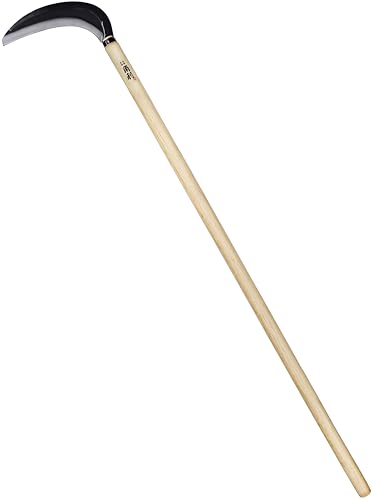Best Weeding Sickle Long Handle
Taming an unruly garden can be a back-breaking task, and the right tools are essential for efficient and enjoyable work. Weeding, in particular, demands precision and leverage, making a quality long-handled weeding sickle an invaluable asset.
With so many options available, however, finding the best weeding sickle long handle for your needs can feel overwhelming. A subpar tool can lead to frustration, wasted time, and even physical strain.
Investing in the best weeding sickle long handle ensures not only effective weed removal but also improved comfort and longevity. In this review article, we’ll explore the key factors to consider when selecting a long-handled weeding sickle, helping you make an informed decision that balances performance and value for years to come.
IN THIS ARTICLE
Top 10 Best Weeding Sickle Long Handle Compared

🏆 BEST OVERALL KAKURI Japanese Weeding Sickle Long Handle 45″ [Thick Blade] Grass Sickle Stand Up Weeding Tool
- Long handle reduces back strain during weeding.
- Sharp Japanese high-carbon steel blade.
- Laminated blade structure enhances durability and sharpening.
- Authentic Japanese craftsmanship and materials.
4.3/5
Check Price on Amazon

🥈 2ND RUNNER UP Haliaeetus Sickle Hoe
- Long handle reduces back strain during weeding.
- Elbow design and sharp blade enhance weeding efficiency.
- Compact size allows for easy maneuverability in tight spaces.
- Sturdy stainless steel construction promises durability.
4.4/5
Check Price on Amazon
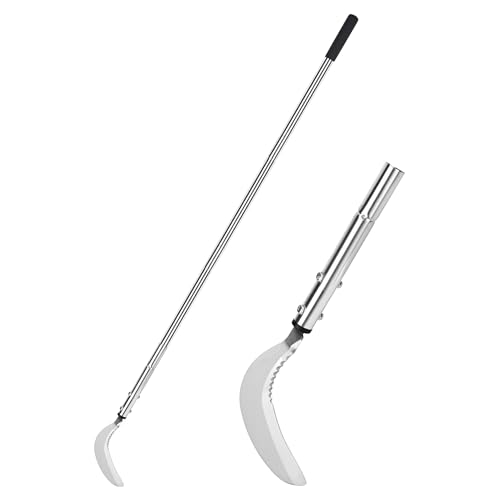
� BEST VALUE YEELOR Weeding Sickle
- Durable stainless steel blade and handle construction.
- Double-edged blade design for versatile cutting.
- Adjustable handle lengths for ergonomic use.
- Lightweight design to reduce arm fatigue.
4.7/5
Check Price on Amazon

Berry&Bird Japanese Weeding Sickle
- Long handle reduces back strain.
- Durable ash wood handle provides a natural grip.
- Versatile for weeding, cultivating, and soil loosening.
- Sharp stainless steel blade cuts through tough soil.
4.4/5
Check Price on Amazon
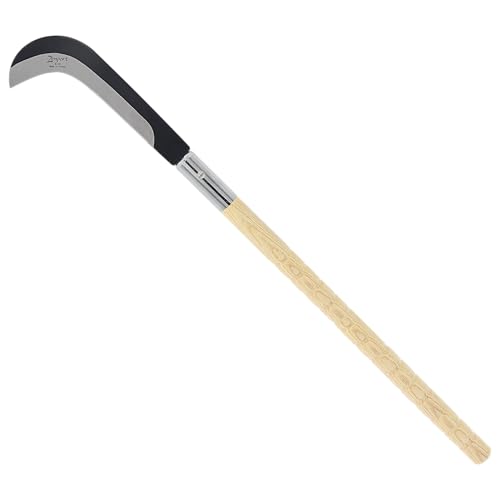
Zenport K318 Sickle, 30.5-inch (77.5cm) Length
- Good length for extended reach (30.5 inches overall).
- Curved blade design aids in cutting and scrubbing.
- Birchwood handle offers a comfortable grip.
- Suitable for clearing tough vines and undergrowth.
4.5/5
Check Price on Amazon
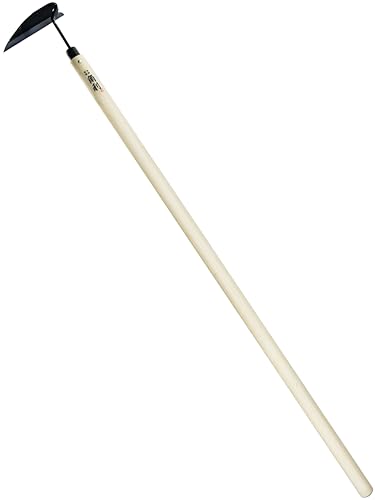
KAKURI Japanese Weeding Tool Long Handle 38″ for G
- Twisted blade design potentially improves weeding efficiency.
- Long handle reduces back strain by allowing standing weeding.
- Japanese steel blade offers good sharpness and durability.
- Laminated blade structure allows for easier resharpening.
4.4/5
Check Price on Amazon
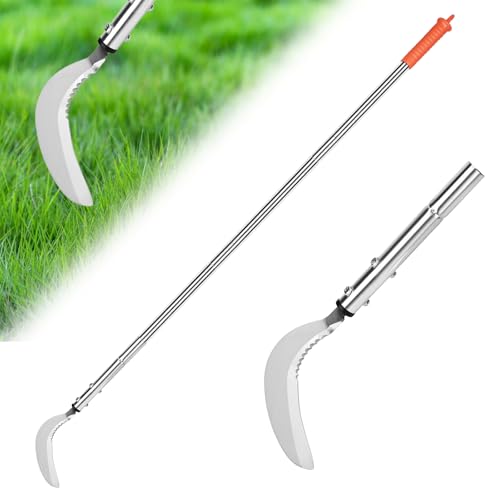
HRADHOL Weeding Sickle
- Adjustable handle suitable for various heights.
- Double-edged blade designed for different types of grass.
- Stainless steel construction for durability.
- Comfortable rubber grip.
4.3/5
Check Price on Amazon

Garden Hoe Long Handle 42-3/4″ Heavy Duty Japanese Stainless Steel
- Long handle reduces back strain during weeding.
- Sharp Japanese stainless steel blade is suitable for various types of grass.
- Rust-resistant material ensures durability.
- Lightweight design enhances maneuverability.
4.8/5
Check Price on Amazon

Berry&Bird 63” Long Handle Crevice Weeding Tool
- Durable stainless steel blade for longevity.
- Ergonomic ash hardwood handle reduces hand fatigue.
- Long handle minimizes bending and kneeling, protecting the back.
- Suitable for removing weeds and moss from cracks and crevices.
4.6/5
Check Price on Amazon

Long Handle Weeding Sickle
- Durable stainless steel blade.
- Adjustable handle length for different user heights.
- Dual-edged blade for varied weeding tasks.
- Relatively easy to assemble.
4.8/5
Check Price on Amazon
Detailed Reviews of the Best Weeding Sickle Long Handle
KAKURI Japanese Weeding Sickle Long Handle 45″ [Thick Blade] Grass Sickle Stand Up Weeding Tool – Long handle reduces back strain during weeding.

This long-handled weed cutter offers a solution for gardeners seeking to reduce back strain during weeding. Its long handle eliminates the need for excessive bending. The blade, crafted from Japanese high-carbon steel, promises sharpness and ease of maintenance, although users should note the need for regular cleaning and oiling to prevent rust.
The laminated blade structure contributes to durability and ease of sharpening. Made in Japan, the tool reflects a commitment to quality materials and traditional craftsmanship. The overall size and blade length seem appropriate for various weeding tasks, though the handle’s ergonomics will likely dictate long-term comfort.
Potential buyers should consider the maintenance requirements associated with carbon steel blades before purchasing.
Pros
- Long handle reduces back strain during weeding.
- Sharp Japanese high-carbon steel blade.
- Laminated blade structure enhances durability and sharpening.
- Authentic Japanese craftsmanship and materials.
- Good blade length for efficient weeding.
Cons
- Carbon steel blade requires regular maintenance (cleaning and oiling) to prevent rust.
- Handle ergonomics may impact comfort during extended use.
Haliaeetus Sickle Hoe – Long handle reduces back strain during weeding.

This Japanese weeding tool aims to simplify gardening by reducing back strain and improving access to tight spaces. The 58-inch handle provides extended reach, minimizing the need to bend over while weeding. Its elbow design and sharp blade facilitate efficient removal of both shallow and deep-rooted weeds.
The compact size is beneficial for maneuvering in confined areas without disturbing nearby plants. Constructed with stainless steel and a solid wood handle, the tool appears durable and comfortable to use. The lifetime warranty offers reassurance regarding the product’s quality and the manufacturer’s commitment to customer satisfaction.
Overall, it seems like a practical tool for gardeners seeking to improve their weeding efficiency and reduce physical strain.
Pros
- Long handle reduces back strain during weeding.
- Elbow design and sharp blade enhance weeding efficiency.
- Compact size allows for easy maneuverability in tight spaces.
- Sturdy stainless steel construction promises durability.
- Comfortable wood handle minimizes hand fatigue.
- Lifetime warranty provides peace of mind.
Cons
- May not be suitable for extremely heavy-duty tasks or very rocky soil.
- Wooden handle, while comfortable, may require occasional maintenance to prevent drying or cracking.
YEELOR Weeding Sickle – Durable stainless steel blade and handle construction.

This grass whip features a stainless steel blade and handle, promising durability. The double-edged blade (straight and wavy) offers versatility for cutting different types of grass and even pulling weeds. It comes in three adjustable lengths, with the lightest option weighing 1.6 lbs, which aims to minimize arm strain during use.
The adjustable handle lengths are a nice touch, potentially reducing back strain by eliminating the need to bend over excessively. The manufacturer suggests a ‘golfing position’ swinging technique for ease of use. While the product seems promising for various weeding tasks, the overall effectiveness will depend on the specific type and density of weeds encountered and user experience with similar tools.
Pros
- Durable stainless steel blade and handle construction.
- Double-edged blade design for versatile cutting.
- Adjustable handle lengths for ergonomic use.
- Lightweight design to reduce arm fatigue.
Cons
- Effectiveness may vary depending on weed type and density.
- Learning curve to the ‘golfing position’ swing technique.
Berry&Bird Japanese Weeding Sickle – Long handle reduces back strain.

The Berry&Bird scuffle hoe presents itself as a versatile garden tool designed for weeding, cultivating, and soil loosening. Its long ash wood handle aims to reduce back strain by extending reach, though assembly is required upon arrival. The ash wood handle feels sturdy and includes a cowhide cord for storage.
The stainless steel blade promises durability and efficiency in cutting through tough soil. While the tool aims to be lightweight and easy to maneuver, the assembly process might be a slight inconvenience for some users. Overall, it seems a decent option for gardeners seeking a multi-purpose tool to maintain their garden beds.
Pros
- Long handle reduces back strain.
- Durable ash wood handle provides a natural grip.
- Versatile for weeding, cultivating, and soil loosening.
- Sharp stainless steel blade cuts through tough soil.
- Includes cowhide cord for easy storage.
Cons
- Requires assembly.
- Handle might be too long for very small gardens or tight spaces.
Zenport K318 Sickle, 30.5-inch (77.5cm) Length – Good length for extended reach (30.5 inches overall).

The Zenport K318 sickle is a straightforward tool designed for clearing dense vegetation. Its 30.5-inch length, with a 20.5-inch birchwood handle, provides decent reach for tackling weeds, vines, and undergrowth. The curved blade aims to facilitate efficient cutting and scrubbing.
While advertised for heavy-duty use, the long-term durability of the blade and its ability to maintain sharpness under sustained stress remain to be seen. The birchwood handle offers a comfortable grip. It is important to consider blade maintenance, as with any cutting tool, to ensure consistent performance.
Pros
- Good length for extended reach (30.5 inches overall).
- Curved blade design aids in cutting and scrubbing.
- Birchwood handle offers a comfortable grip.
- Suitable for clearing tough vines and undergrowth.
Cons
- Long-term blade durability under heavy use is unknown.
- Requires regular blade sharpening and maintenance.
KAKURI Japanese Weeding Tool Long Handle 38″ for G – Twisted blade design potentially improves weeding efficiency.

The KAKURI Nejiri Gama weeding tool offers a unique approach to weed removal with its twisted blade design. The long handle allows for weeding while standing, reducing back strain. The blade is made from Japanese carbon steel and soft iron, promising durability and sharpness.
Its laminated structure should also facilitate easier resharpening. At 12 oz, it’s reasonably lightweight. The poplar wood handle provides a comfortable grip.
While the tool aims for efficiency, users should consider the specific type of weeds they typically encounter to determine if the twisted blade is the most effective solution. It is essential to maintain and clean the blade to ensure it remains in optimal condition.
Pros
- Twisted blade design potentially improves weeding efficiency.
- Long handle reduces back strain by allowing standing weeding.
- Japanese steel blade offers good sharpness and durability.
- Laminated blade structure allows for easier resharpening.
- Relatively lightweight at 12 oz.
Cons
- Blade effectiveness may vary depending on the type of weeds.
- Requires regular maintenance and cleaning to prevent rust/damage.
HRADHOL Weeding Sickle – Adjustable handle suitable for various heights.

This weeding tool features an adjustable long handle, composed of three stainless steel tubes, making it adaptable for users of different heights and potentially reducing back strain during gardening tasks. The double-edged blade, combining straight and wavy shapes, aims to tackle both long and tough grass. The tool is constructed from stainless steel, promising durability and ease of handling.
The rubber grip with multi-layer ring marks should provide a comfortable and secure hold. The manufacturer emphasizes customer support, offering assistance with any product-related questions. While the adjustable handle and double-edged blade appear promising, the overall effectiveness will depend on the quality of the steel and how well it holds an edge during prolonged use.
Pros
- Adjustable handle suitable for various heights.
- Double-edged blade designed for different types of grass.
- Stainless steel construction for durability.
- Comfortable rubber grip.
- Potentially reduces back strain compared to manual weeding.
Cons
- Durability and sharpness retention depend on the quality of the stainless steel.
- Effectiveness may vary based on the type and density of weeds encountered.
Garden Hoe Long Handle 42-3/4″ Heavy Duty Japanese Stainless Steel – Long handle reduces back strain during weeding.

This Japanese weeding hoe offers a potentially back-saving solution for gardeners. The long handle allows for weeding while standing, reducing strain during extended periods. The wavy blade, crafted from Japanese stainless steel, seems capable of tackling both soft and tough grasses.
The stainless steel construction suggests good rust resistance, making it suitable for outdoor use. Its lightweight design (14.6 oz) and moderate blade width (3.5 inches) should make it relatively easy to maneuver. As a product from a established Japanese brand, it is expected to be of good quality.
However, the effectiveness of the blade will depend on the specific type of weeds encountered and soil conditions. Users may still require additional tools for deeply rooted weeds or compacted soil.
Pros
- Long handle reduces back strain during weeding.
- Sharp Japanese stainless steel blade is suitable for various types of grass.
- Rust-resistant material ensures durability.
- Lightweight design enhances maneuverability.
- Made in Japan, promising quality craftsmanship.
Cons
- Blade effectiveness may vary depending on weed type and soil.
- May not be sufficient for deeply rooted weeds or compacted soil.
Berry&Bird 63” Long Handle Crevice Weeding Tool – Durable stainless steel blade for longevity.

This 63″ long-handled crack weeder aims to provide a durable and ergonomic solution for removing weeds and moss from hard-to-reach places. The stainless steel L-shaped blade promises strength and ease of cleaning, while the FSC-certified ash hardwood handle is designed for comfortable grip and reduced hand fatigue. The tool intends to eliminate the need for bending and kneeling, thereby minimizing back strain during gardening tasks.
Assembly is required, but the product includes necessary tools and instructions. While the product boasts a classic design and multi-use functionality for various surfaces like sidewalks, driveways, and plant areas, potential buyers should consider the self-assembly aspect and assess if the blade’s sharpness meets their specific weeding needs.
Pros
- Durable stainless steel blade for longevity.
- Ergonomic ash hardwood handle reduces hand fatigue.
- Long handle minimizes bending and kneeling, protecting the back.
- Suitable for removing weeds and moss from cracks and crevices.
- Classic design aesthetic.
Cons
- Requires self-assembly.
- The sharp blade might pose a safety concern if not handled carefully.
Long Handle Weeding Sickle – Durable stainless steel blade.

This weeding sickle features a stainless steel blade and an adjustable handle, offering versatility for users of different heights. The handle can be adjusted to 20, 36, or 52 inches. The blade has both a straight and a wavy edge, intended for different types of weeds and grass.
The straight edge is designed for lighter tasks, while the wavy edge is for tougher grass. The product includes one sickle with a long handle. Some users may encounter alignment issues during blade installation, requiring slight adjustments.
The manufacturer encourages contacting them for assistance with installation problems. Overall, it seems like a decent tool for basic weeding and grass cutting, though its effectiveness may vary depending on the type and thickness of the vegetation.
Pros
- Durable stainless steel blade.
- Adjustable handle length for different user heights.
- Dual-edged blade for varied weeding tasks.
- Relatively easy to assemble.
Cons
- Potential blade alignment issues during installation.
- Wavy edge might not be effective for very tall or tough grass.
Buying Guide: What to Look For in a Best Weeding Sickle Long Handle
Understanding Your Weeding Needs
Before purchasing the best weeding sickle long handle, assess your specific needs. Consider the types of weeds you typically encounter – are they tough, rooted deeply, or primarily surface-level? Think about the terrain of your garden. Is it flat, uneven, or filled with tight spaces? Also, consider your physical capabilities and any pre-existing back conditions. This assessment will help you narrow down your options and choose a tool that is both effective and comfortable to use. The best weeding sickle long handle is one that meets your individual needs.
Key Features to Consider
Several features distinguish one weeding sickle long handle from another. Handle length is crucial; longer handles reduce back strain but can be cumbersome in confined spaces. Blade material (stainless steel, high-carbon steel) affects durability and sharpness. Blade design (straight, curved, double-edged) influences cutting efficiency for different weeds. Handle material (wood, metal, rubber) impacts grip comfort and overall tool weight. Adjustable handle lengths are beneficial for multiple users. Finally, consider the overall weight of the tool to minimize arm fatigue during prolonged use.
Material and Durability
The material of both the blade and handle significantly impacts the durability and longevity of your weeding sickle long handle. Stainless steel is rust-resistant and easy to maintain, while high-carbon steel offers superior sharpness but requires more diligent care to prevent corrosion. Hardwood handles (like ash) provide a comfortable and natural grip, while metal handles are often more durable. Look for features like laminated blade structures, which enhance durability and simplify sharpening. A sturdy construction ensures the tool withstands regular use and challenging conditions.
Ergonomics and Comfort
Ergonomics are paramount when choosing a weeding sickle long handle. A comfortable grip minimizes hand fatigue, especially during extended weeding sessions. Features like rubber grips or ergonomically shaped wood handles can make a significant difference. Adjustable handle lengths allow you to customize the tool to your height, reducing back strain. Consider the overall weight of the sickle; a lighter tool is easier to maneuver and less tiring to use. Prioritize tools that promote proper posture and minimize bending or kneeling.
Blade Design and Functionality
Blade design dictates the type of weeding tasks the tool excels at. Straight blades are ideal for slicing through surface-level weeds, while curved blades are better for cutting and scrubbing. Double-edged blades offer versatility for tackling various weed types. Thicker blades are more durable and suitable for tougher weeds, while thinner blades offer greater precision. Some sickles feature twisted blade designs, which claim to improve weeding efficiency. Consider the specific types of weeds you commonly encounter when selecting blade design.
Frequently Asked Questions about Best Weeding Sickle Long Handle
What is the ideal handle length for a weeding sickle long handle?
The ideal handle length depends on your height. Generally, a handle length of 40-45 inches is suitable for individuals of average height (5’4″ to 5’10”). Taller individuals may prefer longer handles (45-63 inches) to minimize bending. The goal is to maintain an upright posture while weeding, avoiding excessive strain on your back. Adjustable handles offer the most flexibility, allowing multiple users to comfortably utilize the same tool. Experiment with different lengths to find what feels most natural and comfortable.
How do I maintain the sharpness of the blade on my weeding sickle long handle?
Regular sharpening is essential for maintaining the effectiveness of your weeding sickle long handle. Use a sharpening stone or file designed for blades. Hold the blade at the correct angle (typically around 20-30 degrees) and move the stone along the blade in a smooth, consistent motion. Sharpen both sides of the blade evenly. After sharpening, clean the blade thoroughly and apply a thin coat of oil to prevent rust. Store the sickle in a dry place to further protect the blade.
What are the benefits of using a weeding sickle long handle compared to other weeding tools?
A weeding sickle long handle offers several advantages over traditional weeding methods. The long handle minimizes bending and kneeling, significantly reducing back strain. The sharp blade allows for efficient cutting of weeds, even in tight spaces. The sickle’s design enables precise targeting of weeds, minimizing disturbance to surrounding plants. Compared to chemical herbicides, a weeding sickle provides a safe and environmentally friendly way to control weeds. It is a versatile tool suitable for various weeding tasks.
Can a weeding sickle long handle be used for more than just weeding?
Yes, a weeding sickle long handle can be used for various garden tasks beyond weeding. Some models are suitable for cultivating soil, loosening compacted earth, and even harvesting certain crops. The blade can be used to cut through tough vines and undergrowth. Some gardeners use it for edging lawns or creating clean borders. Look for sickles with durable blades and versatile designs to maximize their functionality for different gardening applications.
What is the difference between a single-edged and a double-edged weeding sickle long handle?
A single-edged weeding sickle has a blade sharpened on one side only, making it suitable for slicing and cutting through weeds in a controlled manner. A double-edged sickle has blades sharpened on both sides, offering increased versatility for different weeding tasks. One edge might be serrated for cutting through tougher vegetation, while the other is smooth for finer work. Double-edged sickles require more caution during use but provide greater flexibility.
What safety precautions should I take when using a weeding sickle long handle?
Always wear appropriate safety gear, including gloves and eye protection, when using a weeding sickle. Keep your hands and feet clear of the blade’s path. Use a firm grip and maintain a stable stance to avoid accidental slips. Be mindful of your surroundings and ensure there are no children or pets nearby. Store the sickle in a safe place, out of reach of children, when not in use. Sharpen the blade regularly to reduce the risk of injury from using a dull tool.
How do I choose the right handle material for my weeding sickle long handle?
Handle material affects grip comfort, durability, and overall tool weight. Wood handles (like ash) offer a natural grip and absorb shock, reducing hand fatigue. Metal handles are durable but can be heavier and less comfortable. Rubber grips provide excellent grip and cushioning, especially in wet conditions. Consider your personal preferences and the type of gardening you typically do when selecting handle material. Choose a material that feels comfortable in your hand and provides a secure grip.
How does the blade curvature affect the performance of a weeding sickle long handle?
Blade curvature influences the tool’s cutting action and suitability for different tasks. A curved blade is effective for cutting and scrubbing weeds, allowing you to reach undergrowth and remove weeds at their roots. A straighter blade is better for slicing through surface-level weeds and creating clean cuts. The ideal curvature depends on the types of weeds you commonly encounter and your preferred weeding technique. Experiment with different blade curvatures to find what works best for you.
What is the best way to store my weeding sickle long handle to prevent rust and damage?
Proper storage is crucial for prolonging the life of your weeding sickle long handle. Clean the blade thoroughly after each use to remove dirt and debris. Apply a thin coat of oil (such as mineral oil or WD-40) to the blade to prevent rust. Store the sickle in a dry place, away from moisture. If possible, hang the sickle vertically to prevent the blade from resting on the ground. A sheath or blade cover can provide additional protection during storage.
How often should I replace my weeding sickle long handle?
The lifespan of a weeding sickle long handle depends on the quality of the materials, the frequency of use, and how well it is maintained. With proper care, a high-quality sickle can last for many years. However, if the blade becomes significantly damaged, excessively worn, or difficult to sharpen, it may be time to replace the tool. Inspect the handle regularly for cracks or signs of wear and tear. Replacing a worn-out sickle ensures efficient and safe weeding.
Conclusion: The Final Verdict
The KAKURI Japanese Weeding Sickle Long Handle 45″ [Thick Blade] Grass Sickle Stand Up Weeding Tool the long handle weed cutter provides a practical solution for reducing back strain during weeding. the japanese steel blade promises efficient cutting, although regular maintenance is a must. if you are okay with the required maintenance, this tool should be a welcome addition to your gardening arsenal.

